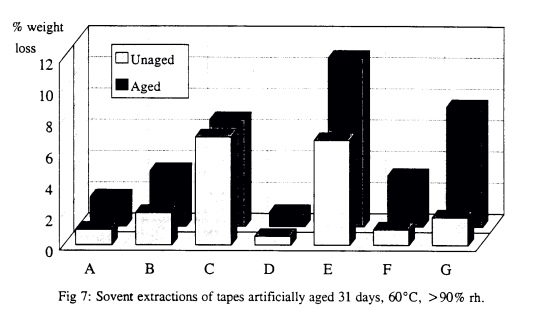Accelerated Aging
Most archives will be involved in recording and/or dubbing older unstable material onto newer, more stable media to preserve the sonic content. It is important to determine at least the relative stability of the formulations available so as to optimise the chances of dubbed material surviving. In order to ascertain the applicability of these methods of analysis for assessment of stability, we regularly study performance of current mastering tapes exposed to high humidity. Whilst a range of conditions are used in accelerated aging, including cycling between low and high humidities and temperatures, we were particularly interested in how tapes performed at high temperature and humidity, and whether this would increase the rate of chemical decomposition. In a recent test over 31 days at 60°C and 90% relative humidity (R.H.), seven popular tapes all showed a greater tendency to shed and an increase in SE [fig 7].

In order to provide repeatable measurements of shedding or binder cohesion, a test jig has been built which rubs a sample of tape held at 500g tension on a 1cm cylindrical swab rotating at 300rpm. The swab is wetted by isopropanol and slowly fed across the tape to avoid clogging. The time to rub completely through the oxide layer is noted. The processes of accelerated aging and analysis by these methods are believed to approximate, rather than completely model actual tape behaviour, although the high degree of repeatability and strong correlation between test results and actual performance has been found to provide a good basis for comparison of different formulations.


